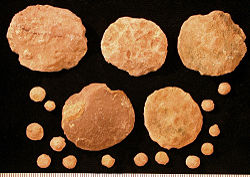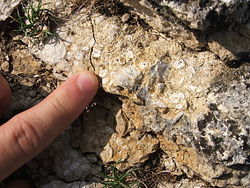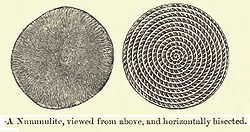- Nummulite
-
Nummulites
Temporal range: TertiaryScientific classification Kingdom: Rhizaria Phylum: Foraminifera Class: Granuloreticulosa Order: Rotaliida Superfamily: Nummulitacea Family: Nummulitidae Genus: Nummulites
Lamarck, 1801Species Numerous
 Fossil nummulitid foraminiferans showing microspheric and megalospheric individuals; Eocene of the United Arab Emirates; scale in mm.
Fossil nummulitid foraminiferans showing microspheric and megalospheric individuals; Eocene of the United Arab Emirates; scale in mm.
 Fossil Nummulites in Urbasa, Basque Country
Fossil Nummulites in Urbasa, Basque Country
A nummulite is a large lenticular fossil, characterized by its numerous coils, subdivided by septa into chambers. They are the shells of the fossil and present-day marine protozoan Nummulites, a type of foraminiferan. Nummulites commonly reach 6 cm (2.4 inches) in diameter, and are common in Tertiary marine rocks, particularly around the Mediterranean (e.g. Eocene limestones from Egypt). Fossils up to 6 inches wide are found in the Middle Eocene rocks of Turkey.2 They are valuable as index fossils.
The name "Nummulites" is a diminutive form of the Latin nummulus meaning "little coin", a reference to their shape. In 1913, Randolph Kirkpatrick published a book, The Nummulosphere: an account of the Organic Origin of so-called Igneous Rocks and Abyssal Red Clays, proposing the theory that all rocks have been constructed by the accumulation of forams such as Nummulites.
References
- 'Nummulite', Tiscali Dictionary of Animals [1], retrieved 17 August 2004
- 2. 'Biggest Microbes', Guinness World Records 2001, p. 153.
Categories:- Foraminifera
- Prehistoric life
- Paleocene life
- Eocene life
- Oligocene life
- Fossils
Wikimedia Foundation. 2010.

